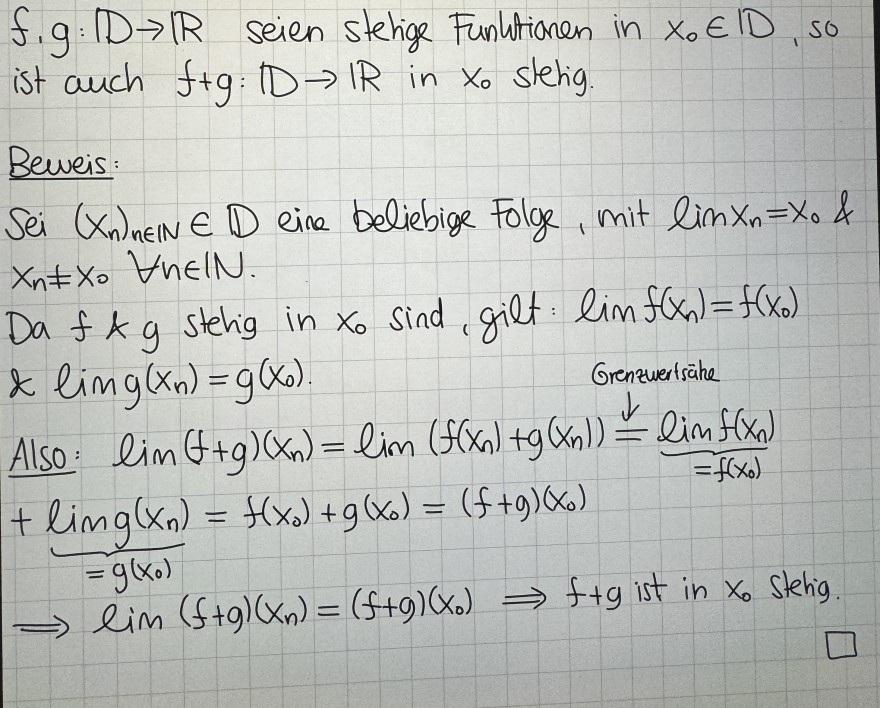Hallo, ich hab eine Klausuraufgabe, die ich mal bearbeitet habe. Es geht darum zu zeigen, wenn zwei Funktionen f und g in einem Punkt x_0 stetig sind, so ist es auch die Summe f + g. Ich habe hier einen Ansatz gemacht, doch sehe ich hier in der Musterlösung, das die das mit der Epsilon-Delta-Definition gemacht haben. Würde denn aber auch mein Ansatz stimmen?
Text erkannt:
Aufgabe 5:
\( f, g: \mathbb{D} \rightarrow \mathbb{R} \) seien stetige Funltionen in \( x_{0} \in \mathbb{D} \), so ist auch \( f+g: \mathbb{D} \rightarrow \mathbb{R} \) in \( x_{0} \) sletig.
Beweis:
Sei \( \left(x_{n}\right)_{n \in \mathbb{N}} \in \mathbb{D} \) eine beliebige Folge, mit \( \lim x_{n}=x_{0} \) \& \( x_{n} \neq x_{0} \quad \forall n \in \mathbb{N} \).
Da \( f \times g \) stehig in \( x_{0} \) sind, gilt: \( \lim f\left(x_{n}\right)=f\left(x_{0}\right) \)
\( k \lim g\left(x_{n}\right)=g\left(x_{0}\right) \).
Grenzuersähe
Also: \( \lim (f+g)\left(x_{n}\right)=\lim \left(f\left(x_{n}\right)+g\left(x_{n}\right)\right) \stackrel{\downarrow}{=} \underbrace{\lim f\left(x_{n}\right)}_{=f\left(x_{0}\right)} \)
\( +\underbrace{\lim g\left(x_{n}\right)}_{=g\left(x_{0}\right)}=f\left(x_{0}\right)+g\left(x_{0}\right)=(f+g)\left(x_{0}\right) \)
\( \Rightarrow \lim (f+g)\left(x_{n}\right)=(f+g)\left(x_{0}\right) \Longrightarrow f+g \) ist in \( x_{0} \) stelig.

Text erkannt:
\( f, g: \mathbb{D} \rightarrow \mathbb{R} \) seien Stelige Funltionen in \( x_{0} \in \mathbb{D} \), so ist auch \( f+g: \mathbb{D} \rightarrow \mathbb{R} \) in \( x_{0} \) sletig.
Beweis:
Sei \( \left(x_{n}\right)_{n \in \mathbb{N}} \in \mathbb{D} \) eire beliebige Folge, mit \( \lim x_{n}=x_{0} \) \& \( x_{n} \neq x_{0} \forall n \in \mathbb{N} \).
Da \( f \times g \) stelig in \( x_{0} \) sind, gilt: \( \lim f\left(x_{n}\right)=f\left(x_{0}\right) \)
\& \( \lim g\left(x_{n}\right)=g\left(x_{0}\right) \).
Grenzwersähe
Also: \( \lim (f+g)\left(x_{n}\right)=\lim \left(f\left(x_{n}\right)+g\left(x_{n}\right)\right) \stackrel{\downarrow}{=} \underbrace{\lim f\left(x_{n}\right)}_{=f\left(x_{0}\right)} \)
\( +\underbrace{\lim g\left(x_{n}\right)}_{=g\left(x_{0}\right)}=f\left(x_{0}\right)+g\left(x_{0}\right)=(f+g)\left(x_{0}\right) \)
\( \Longrightarrow \lim (f+g)\left(x_{n}\right)=(f+g)\left(x_{0}\right) \Longrightarrow f+g \) ist in \( x_{0} \) stelig.